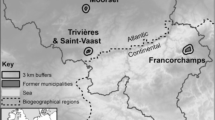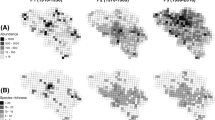Summary
Relationships between species distribution and abundance, the influence of proboscis length on species-packing, and species associations within the local assemblages were studied in local communities of bumblebees in northern Spain along an altitudinal gradient. Local species abundance and altitudinal range occupied accounted for much of the variation in species distribution. Altitudinal range occupied by species was related to species distribution, but the most important variable accounting for species distribution was the local percentage abundance. Despite this, there was no evidence for age abundance. Despite this, there was no evidence for bimodality in the distributions of species incidence. A general trends for mean proboscis length in each locality to be greater in lowland localities exists, but this variable was not related to species distribution or abundance. Proboscis length spacings were studied among species in local assemblages and in most of the cases observed spacing did not differ from random expectations. The same patterns were demonstrated calculating spacings for ‘core’ species in each local assemblage. Furthermore, species showed little tendency towards associations, so it may be concluded that bumblebee assemblages were irregularly structured and no clear patterns emerged from the present study.
Similar content being viewed by others
References
Bowers MA (1985) Bumble bee colonization, extinction and reproduction in subalpine meadows in northeastern Utah. Ecology 66:914–927
Brown JH (1984) On the relationships between abundance and distribution of species. Am Nat 124:255–279
Dixon WJ (1983) BMDP Statistical software. University of California Press, Berkeley, CA, USA
Feinsinger P (1983) Coevolution and pollination. In: Futuyma DJ, Slatkin M (eds) Coevolution. Sinauer Associates Inc., Massachusetts, pp 282–310
Gaston KJ (1988) Patterns in the local and regional dynamics of moth populations. Oikos 53:49–57
Gaston KJ, Lawton JH (1988a) Patterns in body size, population dynamics, and regional distribution of bracken herbivores. Am Nat 132:662–680
Gaston KJ, Lawton JH (1988b) Patterns in the distribution and abundance of insect populations. Nature 331:709–712
Gaston KJ, Lawton JH (1989) Insect herbivores on bracken do not support the core-satellite hypothesis. Am Nat 134:761–777
Gaston KJ, Lawton JH (1990) Effects of scale and habitat on the relationship between regional distribution and local abundance. Oikos 58:329–335
Gotelli NJ, Simberloff D (1987) The distribution and abundance of tallgrass prairie plants: a test of the core-satellite hypothesis. Am Nat 130:18–35
Hanski I (1982a) Dynamics of regional distribution: the core-satellite species hypothesis. Oikos 38:210–221
Hanski I (1982b) Communities of bumblebees: testing the coresatellite hypothesis. Ann Zool Fenn 19:65–73
Hanski I (1982c). Structure in bumblebee communities. Ann Zool Fenn 19:319–326
Heinrich B (1976) Resource partitioning among some eusocial insects: Bumblebees. Ecology 57:874–889
Heinrich B (1979a) Resource heterogeneity and patterns of movement in foraging bumblebees. Oecologia 40:235–245
Heinrich B (1979b) “Majoring” and “Minoring” by foraging bumblebees, Bombus vagans: An experimental analysis. Ecology 60:245–255
Hodges CM (1981) Optimal foraging in bumblebees: Hunting by expectation. Amin Behav 29:1166–1171
Hengeveld R, Haeck J (1981) the distribution of abundance. I. Measurements. J Biogeogr 9:303–316
Husband RW, Fischer RL, Porter WT (1980) Description and biology of bumblebees (Hymenoptera: Apidae) in Michigan. Great Lakes Ent 13:225–239
Inouye DW (1977) Species structure of bumblebee communities in North America and Europe. In: Mattson WJ (ed) The role of arthropods in forest ecosystem. Springer, Berlin Heidelberg New York. pp 35–40
Inouye DW (1980) The effect of proboscis and corolla tube lengths on patterns and rates of flower visitation by bumblebees. Oecologia 45:197–201
Jordano P (1987) Patterns of mutualistic interaction in pollination and seed dispersal: Connectance, dependence asymmetries, and coevolution. Am Nat 129:657–677
Laverty TM, Plowright RC (1988) Flower handling by bumblebees: A comparison of specialist and generalist. Anim Behav 36:733–740
Laverty TM, Harder LD (1988) The bumble bees of Eastern Canada. Can Ent 120:965–987
Ludwig JA, Reynolds JF (1988) Statistical ecology. A primer on methods and computing. John Wiley & Sons, New York
Lundberg H, Ranta E (1980) Habitat and food utilization in a subarctic bumblebee community. Oikos 35:303–310
Macior LW (1978) Pollination ecology of vernal angiosperms. Oikos 30:452–460
Maurer BA (1990) The relationship between distribution and abundance in a patchy environment. Oikos 58:181–189
McCoy ED (1990) The distribution of insects along elevational gradients. Oikos 58:313–322
Morton SR, Davidson DW (1988) Comparative structure of harvester ant communities in arid Australia and North America. Ecol Monogr 58:19–38
Ornosa C (1985) Los abejorros de la fauna Española. N8. Editorial de la Universidad Complutense, Madrid
Owen J, Gilbert FS (1989) On the abundance of hoverflies (Syrphidae). Oikos 55:183–193
Pekkarinen A (1979) Morphometric, colour and enzime variation in bumblebees (Hymenoptera, Apidae, Bombus) in Fennoscandia and Denmark. Act Zool Fenn 158:1–60
Peters RH (1986) The cological implications of body size. Cambridge University Press, Cambridge
Prŷs-Jones OE, Corbet SA (1987) Bumblebees. Cambridge University Press, Cambridge, UK
Pyke GH (1978) Optimal body size in bumblebees. Oecologia 34:255–266
Pyke GH (1980) Optimal foraging in bumblebees: calculation of net rate of energy intake and optimal patch choice. Theor Popul Biol 17:232–246
Pyke GH (1982) Local geographic distributions of bumblebees near Crested Butte, Colorado: competition and community structure. Ecology 63:555–573
Ranta E (1982) Structure of North European bumblebee communities. Oikos 38:202–203
Ranta E (1983) Proboscis length and the coexistence of bumblebee species. Oikos 43:189–196
Ranta E, Tiainen M (1982) Structure in seven bumblebee communities in eastern Finland in relation to resource availability. Holarct Ecol 5:48–54
Ranta E, Vepsalainen K (1981) Why are there so many species? Spatio-temporal heterogeneity and northern bumblebee communities. Oikos 36:28–34
Ranta E, Lundberg H, Teras I (1981) Patterns of resource utilization in two Fennoscandian bumblebee communities. Oikos 36:1–11
Ranta E, Lappalainen K, Miettinen H (1984) Foraging dynamics of two bumblebee species (B. lucorum and B. lapidarius) during one summer. Ann Zool Fenn 21:77–88
Schaffer WM, Jensen DB, Hobbs DE, Gurevitch J, Todd JR, Schaffer V (1979) Competition, foraging energetics, and the cost of sociality in three species of bees. Ecology 60:976–987
Simberloff D, Boecklen W (1981) Santa Rosalia reconsidered: Size ratios and competition. Evolution 35:1206–1228
Strong DR, Szyska LA, Simberloff DS (1979) Test of community-wide character displacement against null hypotheses. Evolution 33:897–913
Wiens JA (1982) On size ratios and sequences in ecological communities: Are there no rules? Ann Zool Fenn 19:297–308
Williams PH (1988) Habitat use by bumble bees (Bombus spp.). Ecol Entomol 13:223–237
Williams PH (1989) Why are there so many species of bumble bees at Dungeness? Bot J Linn Soc 101:31–44
Wilson DS (1975) The adequacy of body size as a niche difference. Am Nat 109:769–784
Author information
Authors and Affiliations
Rights and permissions
About this article
Cite this article
Obeso, J.R. Geographic distribution and community structure of bumblebees in the northern Iberian peninsula. Oecologia 89, 244–252 (1992). https://doi.org/10.1007/BF00317224
Received:
Accepted:
Issue Date:
DOI: https://doi.org/10.1007/BF00317224




